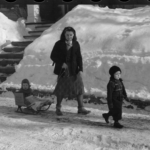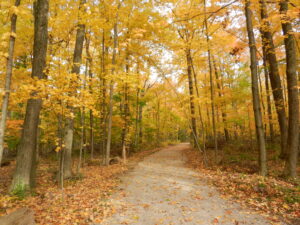By Robin Mayes, Farm Educator

Layers are great, especially when they are associated with cakes or sedimentary rock formations! Here in Ohio, they can be even more beneficial when associated with cold weather clothing. Almost daily during the cold months we hear people complain about winter temperatures. Often, they are in a hoodie and jeans or in a winter coat gaping open revealing just a t-shirt under.
When I was a kid (I know, I start ALL my blogs that way.) the warm, light, down-filled vests and jackets we have all come to take for granted today were not readily available. Some people were enjoying them, however. After a brush with hypothermia while fishing and inspired by eiderdown quilts, Eddie Bauer patented a goose down jacket back in 1940. But, I don’t remember seeing them for us average, midwestern folks (at an affordable price) until they became popular in the late 80’s and were sometimes called “puffer” coats.
Of course, historically, people living in frigid areas have used layers of feathers and down to keep warm for centuries. I am talking commercially available clothing here. During my childhood, I had only seen feathers and down make their way into scratchy pillows and big, fluffy duvet-type things called “ticks” that grandma’s and aunts kept in their spare bedrooms. These would be put down on the floor for kids to sleep upon when the family spent the night.

Before down jackets became the norm, kids’ coats were usually wool or maybe cotton corduroy or denim with a thin, quilted lining. These somewhat inadequate outer layers were made effective by the addition of a thick, handknit sweater underneath. Every family had a skilled knitter or two it seemed. A long-sleeved undershirt completed the layering for the torso. Because as a farmer he spent most of his time outside, my dad also wore the ‘under armour’ of earlier times … the ‘union suit’, or ‘long johns’- a set of thermal underwear. It was joked that some put them on in the fall and did not take them off until spring.
When my kids were young and wanted to go out for a day of play in the snow, I zipped them into thick, quilted one-piece snowsuits. These suits were so thick and cumbersome that once the poor child was cocooned in it, mummy-like, they could hardly play. If they fell over, they were hard-pressed to right themselves. One advantage to those slippery nylon snowsuits of the 1970’s was that they could slide down a hill without a sled!
When George Mallory and Andrew ‘Sandy’ Irvine attempted the ascent of Mt. Everest in 1924 they were outfitted in the mountaineering attire of the day. Sadly, they ascended into the clouds on that day and were never seen again until May of 1999. That was when the body of George Mallory was discovered on the northeast ridge of the mountain. It had always been hoped that, could the remains of Mallory or Irvine be found, it would set to rest the mystery of whether they summited. Unfortunately, the camera the two had carried to document the event was not with Mallory’s remains. The photo of his wife that he had planned to place on the summit was also NOT in any of his pockets, leading some to conclude they must have reached the top that day. Most are not convinced, however. Some climbers were adamant that the 1924 expedition was ill-equipped for the endeavor, pointing to the primitive hobnail boots and woolen coats, and concluding they could not have stood at the top of the world back then. The official first ascent of Everest wouldn’t come until 1953 when New Zealander Edmund Hillary and Sherpa Tenzing Norgay attained it.
Interestingly though, some sought to debunk the thought that the clothing was detrimental for Mallory and Irvine. Researchers recreated Mallory’s clothing and boots. Two mountaineers, one clad in a modern suit and boots and the other in the replicated equipment, set out for the top of Everest. The vintage-style clothing actually proved to be more comfortable and easier in which to climb! (For the full story see: http://news.bbc.co.uk/2/hi/science/nature/5076634.stm )
So, even if you don’t have the latest and greatest outdoor-wear, just start layering up, get outside and tackle one of the park district’s sledding hills located at Blues Creek Park and Gallant Woods Park—the closest things to Mt. Everest in Delaware County!







